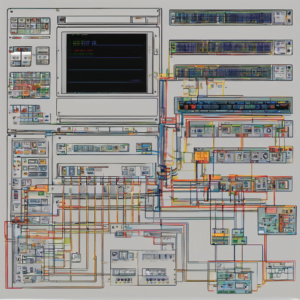In hardware design and verification projects, mastering System Verilog case statements is vital. These case statements are necessary for controlling logic, designing state machines, and building other hardware components.
At their core, SystemVerilog case statements are used for selecting values based on a specific input. They’re incredibly versatile, allowing engineers to write efficient and maintainable code.
In this article, we’ll explore the syntax and usage of SystemVerilog case statements, best practices for writing them effectively, and how they can be applied to hardware design and verification. We’ll also discuss advanced techniques and features, as well as strategies for debugging and troubleshooting.
Key Takeaways:
- SystemVerilog case statements are essential in hardware design and verification
- Case statements select values based on specific inputs, making them incredibly versatile
- Writing efficient and maintainable SystemVerilog case statements requires understanding syntax
- Best practices for writing SystemVerilog case statements include proper indentation and commenting
- Case statements can be leveraged for stimulus generation, checking expected results, and troubleshooting
Understanding SystemVerilog Case Statements
When dealing with hardware design and verification projects, SystemVerilog case statements are an essential tool that every engineer needs to master. In simple terms, case statements allow us to define a set of conditions and corresponding actions to be taken by the system when those conditions are met.
SystemVerilog case statements are similar to switch statements in other programming languages, but they are specifically designed to accommodate hardware design and verification projects. They enable us to write clear and concise code while also minimizing the risk of errors and ambiguities. With case statements, we can improve the readability and maintainability of our code by making it easier to debug, update, and modify over time.
SystemVerilog case statements can handle several conditions and actions at once and can include both explicit and implicit conditions. Explicit conditions are conditions that we specify directly in the case statement, while implicit conditions are based on the size, sign, or range of the variable being evaluated. Case statements can also include a default case, which specifies what action should be taken if none of the other conditions are met.
Overall, understanding the fundamentals of SystemVerilog case statements is critical to designing efficient and reliable hardware systems. In the next section, we will look at the syntax and usage of SystemVerilog case statements, where we will explore some practical examples to illustrate how they can be used in different scenarios.
Syntax and Usage of SystemVerilog Case Statements
In SystemVerilog, a case statement is a powerful construct that allows us to compare an expression to multiple alternatives and execute corresponding statements based on a matching pattern. This section will focus on the syntax and usage of SystemVerilog case statements and provide examples to illustrate their practical application.
Syntax of SystemVerilog Case Statements
The basic syntax of a SystemVerilog case statement is as follows:
| case (expression) <case_item1>: statement(s); <case_item2>: statement(s); …. <case_itemN>: statement(s); endcase |
The expression enclosed within the “case” keyword can be of any data type, including enumerated types and user-defined types. The case items enclosed within their respective labels and statement blocks can be one of the following types:
- Constant expressions
- Wildcard default case (represented by “default:” label)
- Expression with range (represented by “min:max” format)
- Expression with one or more bits set (represented by “bit_pattern” format)
- Expression with all bits set (represented by “default” format)
Usage of SystemVerilog Case Statements
SystemVerilog case statements can be used in various scenarios, such as:
- Implementing state machines, where each state is represented by a case item
- Implementing control logic, where each control input is matched against a case item
- Validating test results, where each expected result is compared against an actual result
Here is an example of a SystemVerilog case statement used in a state machine:
| case (state) <STATE_A>: begin statement(s) for State A <STATE_B>: begin statement(s) for State B <STATE_C>: begin statement(s) for State C endcase |
This case statement matches the current “state” variable against three predefined state names and executes the corresponding statement block for each matching item.
In addition to basic case statements, SystemVerilog offers several advanced features, such as wildcard case items, overlapping case items, and parallel case statements. These advanced techniques can enhance the functionality and flexibility of case statements in complex hardware designs.
Now that we have covered the syntax and usage of SystemVerilog case statements in detail, let’s move on to best practices for writing efficient and maintainable code using these constructs.
Best Practices for Writing SystemVerilog Case Statements
Writing effective SystemVerilog case statements is essential for creating efficient and maintainable code in hardware design and verification projects. In this section, we will present a set of best practices that we recommend following:
Proper Indentation
Indentation is crucial in improving the readability of your code. Make sure to indent your case statements correctly, aligning each case item under its associated case keyword. We recommend using four spaces for each indentation level.
Comments
Adding comments to your code is an excellent way to enable others to understand your design better, especially when working collaboratively. Make sure to add clear and concise comments to your case statements, explaining the logic behind each item. Consider placing a comment above each case item to make it more readable.
Default Case
Always include a default case in your case statements. The default case will handle any value not covered by the other case items. By doing so, you can avoid undefined behavior and add safety to your design.
Break Statements
Make sure to include break statements at the end of each case item. By doing so, you can ensure that the execution of your code will exit the case statement and continue executing the rest of your code. Not adding break statements can lead to unexpected behavior and errors.
By following these best practices for writing SystemVerilog case statements, you can create efficient, maintainable and reliable code for your hardware design and verification projects.
Using SystemVerilog Case Statements in Hardware Design
SystemVerilog case statements are a vital tool in the hardware designer’s arsenal. They allow us to express complex logic in a way that is concise, readable, and maintainable. In this section, we will explore how case statements can be used to design control logic, state machines, and other hardware components.
Control Logic
In digital systems, control logic is responsible for managing the flow of data and control signals. Control logic can be implemented using SystemVerilog case statements, which offer a flexible and intuitive syntax for describing actions based on input conditions.
For example, consider a simple case statement that controls an LED blink rate:
| Input Signal | LED Blink Rate |
| 00 | Off |
| 01 | 1 Hz |
| 10 | 2 Hz |
| 11 | 4 Hz |
Here, we have a two-bit input signal that controls the blink rate of an LED. By using a case statement, we can easily map each input condition to its corresponding output, simplifying the implementation of the control logic.
State Machines
State machines are a fundamental building block of digital systems, used to model complex behaviors and sequences of operations. SystemVerilog case statements can be used to implement state machines using a state-encoding scheme, such as one-hot encoding or binary encoding.
For example, consider a simple binary-state machine that counts from 0 to 3:
| Current State | Next State | Output |
| 00 | 01 | 0001 |
| 01 | 10 | 0010 |
| 10 | 11 | 0100 |
| 11 | 00 | 1000 |
Here, we have a two-bit binary-state machine that counts up from 0 to 3, outputting a four-bit binary code at each state. By using a case statement, we can define the next state and output for each state, creating a simple and effective state machine implementation.
Code Readability and Reusability
By using SystemVerilog case statements in our designs, we can improve code readability and reusability. Case statements allow us to group related conditions and actions into one place, making it easier to understand what the code is doing. This can be especially useful for large or complex designs, where keeping track of individual conditions and actions can be challenging.
Moreover, by encapsulating related functionality in case statements, we can promote code reuse. We can define case statements for commonly used functions and conditions, then reuse them across multiple designs, saving time and effort.
In conclusion, SystemVerilog case statements are a powerful tool for hardware designers, offering a flexible and intuitive syntax for expressing complex logic. By leveraging case statements in our designs, we can improve code readability, promote code reuse, and implement effective control logic and state machines.
Leveraging SystemVerilog Case Statements for Verification
As we’ve previously discussed, SystemVerilog case statements are an indispensable tool for designing hardware components and control logic. In addition to their benefits for hardware design, case statements are also a valuable asset in hardware verification projects.
Verification engineers rely on efficient and comprehensive testbenches to verify designs and uncover any potential bugs or issues. SystemVerilog case statements can help with this task by enabling stimulus generation, expected result checking, and corner case handling. By harnessing the power of case statements in the verification process, engineers can produce robust and reliable designs that meet the highest quality standards.
One of the primary advantages of using SystemVerilog case statements for verification is their ability to generate different input combinations automatically. With case statements, engineers can specify different input datasets and quickly generate a comprehensive set of test scenarios that cover all possible test cases.
Another key benefit of case statements in verification is their ability to handle corner cases. Verification engineers need to verify that designs operate correctly within a wide range of input conditions, including rare and unusual scenarios. Using SystemVerilog case statements for corner case handling ensures that all input combinations are covered and that designs work as expected in any situation.
Finally, verification engineers can use case statements to check expected results, ensuring that designs generate the correct output in response to different input stimuli. With case statements, engineers can specify the expected results for each test scenario and run automated checks to verify that designs meet these expectations.
In conclusion, SystemVerilog case statements are a powerful tool for designing and verifying hardware components. By leveraging case statements for stimulus generation, corner case handling, and expected result checking, engineers can produce high-quality designs and verify them quickly and efficiently.
Debugging and Troubleshooting SystemVerilog Case Statements
SystemVerilog case statements are an essential part of hardware design and verification projects. However, like any code, they can sometimes lead to unexpected results or errors. In this section, we will explore common issues that may arise when working with case statements and provide effective strategies for debugging and troubleshooting.
Common Issues with SystemVerilog Case Statements
One common issue when working with case statements is incorrect syntax or usage. This can lead to unexpected behavior or incorrect results. Another issue is forgetting to handle default cases properly, which can cause simulations to fail or produce unexpected results.
Debugging Strategies
Debugging SystemVerilog case statements requires a systematic approach. One common strategy is to use print statements or waveform viewers to track the flow of code and analyze how values change over time. Another strategy is to use the interactive debuggers provided by many simulation tools. These debuggers allow engineers to step through code, set breakpoints, and inspect variables in real-time.
Troubleshooting Strategies
When troubleshooting SystemVerilog case statements, engineers should first re-examine their code for syntax errors or incorrect usage. They should also check their testbench for proper stimulus generation, including handling of edge cases and default scenarios. If all else fails, engineers may need to consult documentation, online forums, or seek advice from colleagues.
Advanced Techniques and Features of SystemVerilog Case Statements
SystemVerilog case statements offer a wide range of advanced techniques that can greatly enhance their functionality and flexibility in hardware design and verification. In this section, we will explore some of these advanced features, including:
- Wildcards: With wildcard matching, we can match any value of a certain type, making case statements more efficient and concise, particularly when there are multiple conditions to check.
- Overlapping case items: Overlapping case items help in simplifying the code, enabling us to handle certain combinations of inputs without having to write separate code snippets for each scenario.
- Parallel case statements: Parallel case statements are useful when designing state machines with multiple conditions that need to be evaluated simultaneously. They make code concise, easy to read and understand, and improve program efficiency.
These advanced techniques are powerful tools that can help engineers write more sophisticated and complex code with ease, while improving performance and reducing runtime errors. However, they require careful consideration and knowledge, as they can also introduce potential issues and bugs if not used correctly.
Conclusion
As we have learned throughout this article, mastering SystemVerilog case statements is an essential skill for any hardware design and verification engineer. By understanding their syntax, following best practices, and leveraging their power, we can write efficient and maintainable code that improves productivity and ensures high-quality designs.
Whether you are designing control logic, state machines, or other hardware components, case statements offer a powerful tool for improving code readability and reusability. Additionally, in the context of hardware verification, case statements play a crucial role in helping engineers write efficient and comprehensive testbenches.
While SystemVerilog case statements are a fundamental feature, it’s important to remember that they also offer advanced features for enhancing their functionality and flexibility. By utilizing techniques such as wildcards, overlapping case items, and parallel case statements, we can take advantage of their full potential.
Through following best practices and continuously developing our knowledge of SystemVerilog case statements, we can ensure our designs are of the highest quality and improve our productivity as hardware design and verification engineers.



![What is FPGA Introduction to FPGA Basics [2023] computer-chip-dark-background-with-word-intel-it](https://fpgainsights.com/wp-content/uploads/2023/06/computer-chip-dark-background-with-word-intel-it-300x171.jpg)








